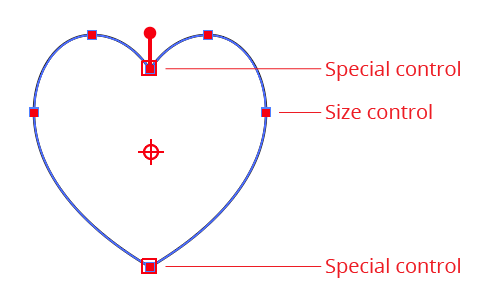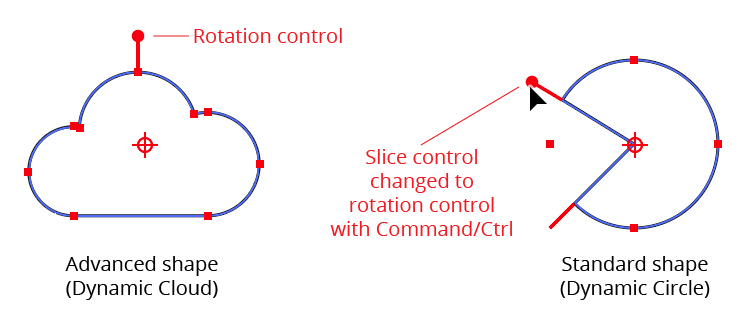 Editing Existing Shapes
Editing Existing Shapes
The Dynamic Shapes tool edits existing shapes by clicking and dragging on the various control annotations that each shape displays. Below, functionality is described from the perspective of editing a single shape, but multiple Dynamic Shapes may of course be edited simultaneously. When the Dynamic Shapes cursor is over an annotated control, the cursor will change from a crosshair to a solid, tail-less arrow.
Additionally, when a Dynamic Shape is selected which supports a variable numbers of segments, sides or corners, the “Decrease Diameter” and “Increase Diameter” keys may be used to change this value, even when the mouse button is up. These keystrokes are set in Illustrator’s “Keyboard Shortcuts” dialog; by default, they are the left and right square bracket keys [ ] respectively.
Transformation Point Edits
Clicking
Selects the shape and deselects everything else. If Shift is held down, previously-selected objects will not be deselected first.
Doubleclicking
Resets the transformation point’s position to the center of the shape.
Dragging
Moves the Dynamic Shape. Other selected, non-Dynamic Shape art is not moved. When Smart Guides are off, the transformation will still snap to anchor points and other shapes’ transformation points. While dragging, several keys can be pressed to modify functionality:
Shift: Constrains the movement of the shape to 45° increments around the general constrain angle.
Option/Alt: Duplicates the shape to the new location.
Command/Ctrl: Moves the transformation point within the shape’s bounding box without moving the shape.
D: Toggles Duplicate Shape mode. When enabled,
Option/Altdoes not need to be held down to duplicate the shape.U: Temporarily disables Smart Guides, if they were enabled when the drag started.
Size Control Edits
The small, filled square annotations on selected Dynamic Shapes are size controls. In general, they appear at the positions of the shape’s anchor points (if corners were absent). Note: some advanced shapes have special controls which change a different parameter of the shape; by default, they appear as a size control surrounded by a second unfilled square:

Dynamic Shapes size control edits
Dragging
Dragging a size control with the Dynamic Shapes tool changes the size of the shape by scaling it up or down relative to its transformation point. If the shape has corners, the corner radii are not changed unless Shift is held down (see below) or the shape becomes so small that corners of the original radii are no longer possible. If multiple shapes are selected, scaling is proportional. In other words, scaling the shape under the cursor by 75% will cause all selected Dynamic Shapes to be scaled by 75% and so on. While dragging, several keys can be pressed to modify functionality:
Shift: For standard shapes, scales any corners along with the shape itself.
Option/Alt: For standard shapes, defines the corner radii; cursor motion makes the corners larger or smaller rather than changing the shape’s size.
Command/Ctrl: For shapes with two independent sizes, unlocks the shape’s aspect ratio, as when drawing a new shape (see Dynamic Shapes Tool: Creating New Shapes).
Space: Moves the entire shape without changing its size.
Left Arrow/Right Arrow: For standard shapes, changes the corner radii. If radii are different, they are changed proportionally.
D: Toggles Duplicate Shape mode. When enabled, when the edit is completed by releasing the mouse button, a new shape will be created with the new parameters; the original shape is untouched.
T: Shifts the transformation point between each of the nine standard positions (top-left, top-center, etc). If the transformation point is shifted, the new position will be used for all further cursor movement.
U: Temporarily disables Smart Guides, if they were enabled when the drag started.
Corner Radius Control Edits
The small filled circle annotations on selected standard Dynamic Shapes are corner radius controls.
Doubleclicking
Doubleclicking a corner radius control with the Dynamic Shapes tool removes all of the shape’s corners. If Option/Alt is held down while doubleclicking, only the corner under the cursor is removed.
Dragging
Dragging a corner radius control with the Dynamic Shapes tool changes the radii of the shape’s corners. If the corners have different radii, then the corners are changed in proportion to the dragged corner (for example, if the radius of the dragged corner is halved, then the radii of all other corners will be halved). If Option/Alt is held down while dragging, only the corner under the cursor is changed.
Slice Control Edits (Standard Shapes Only)
Standard shapes (those in the first row) can be “sliced,” such as you might slice a pie. You can adjust slicing using the tool with the slice controls, which are red (by default) lines on the outside of the shape. One line controls the start slice position and the other controls the end. When the shape is unsliced, both values are the same and the lines appear as one. Slicing is always done to the center of the shape.

Dynamic Shapes Slices Examples
Doubleclicking
Doubleclicking either slice control resets both the start slice and end slice to zero, removing the slice.
Dragging
Dragging a slice control changes the slice value. While dragging, several keys can be pressed to modify functionality:
Shift: Constrains the slice angle to 45° increments around the general constrain angle.
Option/Alt: Links or unlinks the slice angles. When linked, moving the end slice control will simultaneously move the start slice control by the same amount. The initial state of slice linking is set in the panel.
Command/Ctrl: Changes the slice control into a rotation control (see Rotation Control Edits below).
D: Toggles Duplicate Shape mode. When enabled, when the edit is completed by releasing the mouse button, a new shape will be created with the new parameters; the original shape is untouched.
Rotation Control Edits
The rotation control resembles the slicing control, but has a small circle on the end, like a lollipop. Since advanced shape types do not support slicing, they always display this control. For standard shapes, holding down Command/Ctrl when mousing down over a slicing control converts it temporarily into a rotation control:

Dynamic Shapes Rotation Control Edits
Shape rotation is around the shape’s transformation point. When dragging the rotation control to rotate the shape(s), you can add Shift to constrain the rotation to 45° increments around the general constrain angle, and D to toggle Duplicate Shape mode, as previously described.
Special Control Edits
Most of the advanced shapes have special annotated controls which let you adjust one or more of their non-standard parameters without using the Dynamic Shapes panel:

Dynamic Shapes Special Control Edits
Dynamic Arrow: The special controls on a Dynamic Arrow let you change its Tip Angle. Additionally, you can drag the sides of the arrow to adjust its Thickness, and the base of the arrow to adjust its height without affecting its width.
Dynamic Crescent: The special controls on a Dynamic Crescent let you change its Outer and Inner widths.
Dynamic Cross: The special controls on a Dynamic Cross let you change its Thickness and Offset.
Dynamic Gear: The special controls on a Dynamic Gear let you change its Tooth Height.
Dynamic Heart: The special controls on a Dynamic Heart let you change its Depth and Point.
Dynamic Speech Bubble: The special controls on a Dynamic Speech Bubble let you change its Tail Height, Tip, and Join positions. To move one Join position independently of the other, hold down
Option/Altwhen dragging it.
